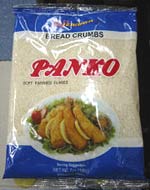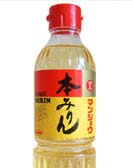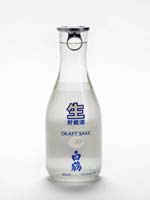 Serves 4 Serves 4 |
||
|
This dish is a Japanese adaption of the French potato croquette. There are two main types, one
made with a thick white sauce (bechamel) and the other with meat and potato. This recipe uses
a thick white sauce as a base adding roasted pumpkin as a flavouring. This means it is possible to add any vegetable puree to create your own korokke. Keep and freeze any leftover korokke mix as it can be used in the next cheeseless pizza recipe. |
||
|
Ingredients 1 butternut squash or small pumpkin A little sesame oil 80g (3oz) butter 60g (2oz) plain flour 300ml (10 floz ) milk 1 teaspoon salt 2 eggs 200ml (1 cup) milk breadcrumbs 1 tbsp sesame seeds Oil for deep frying Tonkatsu sauce 30ml (2tbsp) tomato sauce 20ml (1tbsp) vegetarian worcester sauce or Hendersons or HP brown sauce 30ml (2tbsp) mirin 20ml (2tbsp) sake 1 thumb of fresh ginger, grated 20ml (2tbsp) soy sauce 2 teaspoons white sugar |
First take a whole butternut squash, cut it in half lengthways, scoop out the seeds and place the two sides on a baking tray. Drizzle over some sesame oil and sprinkle over some salt and pepper. Roast the squash for 80 minutes until soft all the way through when poked with a knife. Allow it to cool and then refridgerate. |  |
| Melt the butter in a small saucepan. When melted add the flour and stir it in with a wooden spoon. Turn down the heat and allop the flour to cook in the butter for a couple of minutes until it becomes sandy in texture. |  |
|
|
Then whisking all the time add the milk. It will thicken straight away so keep adding the milk
until it is all used. Keep whisking vigorously. It will get very thick - that is exactly what
you want. When it is thick take the bechamel or white sauce off the heat. Cool to room
temperature and then cool to fridge temperature. korroke are much easier to roll if the mixtures are very cold so it would be my advice to make the bechamel the day before and give it time to cool in the fridge overnight. |
 |
|
| In a bowl mash up the cooled roasted squash. Fold in the bechamel and check the seasoning. Add a little more salt if you think it needs it. |  |
|
|
Whisk the eggs and the milk togther and place the mixture in a bowl. Place some plain flour in a
separate bowl and the breadcrumbs mixed with the sesame seeds in another. Place spoonfuls of the mixture into the flour and mould them with your hands into patties. Dip these patties in the egg mixture and finally in the breadcrumbs. After they have been in the breadcrumbs reshape them and place them on a tray. |
 |
|
|
Bring a deep fat fryer or wok of oil to a temperature of 180°C (356°F) and deep fry
the korokke until they are golden brown. Drain off any excess oil on kitchen paper. Serve hot or cold with mayonnaise and /or the tonkatsu
sauce if you have the ingredients. For the Tonkatsu sauce just simply mix the ingredients together in a pan and simmer them for a few minutes. Cool and use. Tonkatsu sauce will keep for ages in the fridge. |
 |
|






